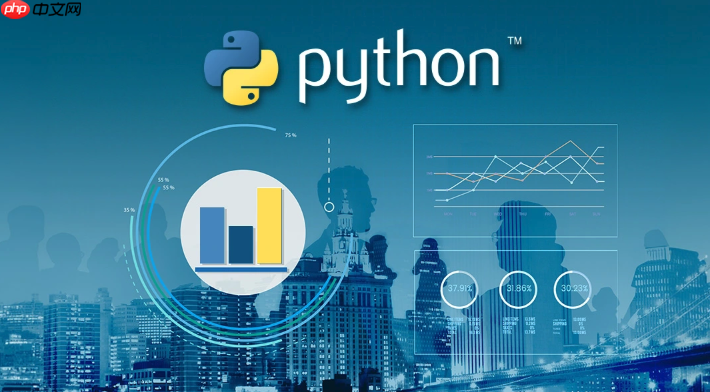os.system执行命令并返回状态码,但无法捕获输出且阻塞执行;os.popen通过管道可读取命令输出,适合需处理输出的场景;两者均存在安全和控制力不足问题;相较之下,subprocess模块提供更精细控制、独立捕获stdout/stderr、更好错误处理及安全性,是执行系统命令的推荐方式。

Python的
os
os.system
os.popen
os.system
os.popen
当我们需要在Python中执行外部系统命令时,
os.system
os.popen
os.system(command)
command
import os
# 执行一个简单的命令,例如列出当前目录内容
print("--- 使用 os.system 列出当前目录 ---")
return_code = os.system('ls -l') # 在Windows上可能是 'dir'
print(f"命令执行完毕,返回码: {return_code}")
# 尝试执行一个不存在的命令,看看返回码
print("\n--- 尝试执行一个不存在的命令 ---")
return_code_fail = os.system('non_existent_command')
print(f"命令执行完毕,返回码: {return_code_fail}")而
os.popen(command, mode='r', bufsize=-1)
'r'
os.popen
read()
readline()
立即学习“Python免费学习笔记(深入)”;
import os
# 使用 os.popen 捕获命令输出
print("--- 使用 os.popen 捕获 'echo hello world' 的输出 ---")
with os.popen('echo hello world') as f:
output = f.read()
print(f"命令输出:\n{output}")
# 捕获多行输出,例如列出目录并过滤
print("\n--- 使用 os.popen 捕获 'ls -l | grep .py' 的输出 ---")
# 注意:在Windows上,grep需要自行安装或使用findstr
command = 'ls -l | grep .py' # Linux/macOS
# command = 'dir | findstr ".py"' # Windows
with os.popen(command) as f:
print("Python文件列表:")
for line in f:
print(line.strip())
# os.popen 也可以获取命令的退出状态,但需要先关闭文件对象
# 且其返回的退出状态是操作系统级别的,不是直接的命令退出码,
# 更多时候我们通过解析输出来判断成功与否,或者结合其他方法。
# 例如,通过 f.close() 获取的可能是 None 或 OSError 异常
# 实际的退出状态通常需要结合 subprocess 模块获取。从我的经验来看,
os.system
os.popen
os.system
其次,
os.system
再者,它的安全性也值得我们注意。
os.system
os.system
最后,
os.system
os.system
os.popen
os.system
os.popen(command)
要高效捕获输出,关键在于如何正确地读取这个文件对象。最常见的做法是使用
read()
readlines()
import os
print("--- 逐行读取 'ping -c 4 localhost' 的输出 ---")
# 注意:Windows上 ping 命令参数可能不同,例如 'ping localhost -n 4'
command = 'ping -c 4 localhost' # Linux/macOS
# command = 'ping localhost -n 4' # Windows
with os.popen(command) as f:
for line in f:
print(f"处理中: {line.strip()}")
# 这里你可以对每一行输出进行实时处理,比如解析、过滤或存储这种逐行读取的方式非常高效,因为它不需要一次性加载所有输出到内存,尤其适合处理那些会持续输出信息的命令,比如日志查看工具或者长时间运行的服务状态监控。
需要注意的是,
os.popen
os.popen
f.close()
subprocess
os.popen
os.popen
谈到在Python中执行系统命令,如果只停留在
os.system
os.popen
subprocess
subprocess
os.system
os.popen
最主要的区别在于控制粒度。
os.system
os.popen
subprocess
subprocess.run()
subprocess.Popen
举个例子,
subprocess.run()
CompletedProcess
import subprocess
print("--- 使用 subprocess.run 捕获命令输出和错误 ---")
try:
# command = ['ls', '-l'] # Linux/macOS
command = ['dir'] # Windows
result = subprocess.run(command, capture_output=True, text=True, check=True)
print(f"命令成功执行,退出码: {result.returncode}")
print(f"标准输出:\n{result.stdout}")
if result.stderr:
print(f"标准错误:\n{result.stderr}")
except subprocess.CalledProcessError as e:
print(f"命令执行失败,退出码: {e.returncode}")
print(f"标准输出:\n{e.stdout}")
print(f"标准错误:\n{e.stderr}")
# 尝试一个会报错的命令
print("\n--- 使用 subprocess.run 捕获错误输出 ---")
try:
# command_fail = ['cat', 'non_existent_file.txt'] # Linux/macOS
command_fail = ['type', 'non_existent_file.txt'] # Windows
result_fail = subprocess.run(command_fail, capture_output=True, text=True, check=True)
except subprocess.CalledProcessError as e:
print(f"命令执行失败,退出码: {e.returncode}")
print(f"标准错误:\n{e.stderr}")subprocess
check=True
subprocess.run()
CalledProcessError
os.system
os.popen
安全性方面,
subprocess
shell=True
所以,虽然
os.system
os.popen
subprocess
subprocess
os
subprocess
os.system
以上就是python如何使用os模块执行系统命令_python os.system与os.popen使用方法的详细内容,更多请关注php中文网其它相关文章!

python怎么学习?python怎么入门?python在哪学?python怎么学才快?不用担心,这里为大家提供了python速学教程(入门到精通),有需要的小伙伴保存下载就能学习啦!

Copyright 2014-2025 https://www.php.cn/ All Rights Reserved | php.cn | 湘ICP备2023035733号